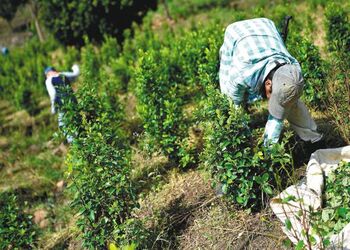Cheap coca leaves and cocaine paste from Peru are flooding into neighboring Bolivia due to a longstanding price imbalance between the two countries. As Peru’s cultivation rises alongside Bolivian cocaine production, this relationship seems cemented in place.
Coca and cocaine paste from Peru have been entering Bolivia through at least 10 trafficking routes, according to an August 29 report by newspaper El Deber, citing operations and seizures made by Bolivia’s Directorate of Coca Leaf and Industrialization (Dirección General de la Hoja de Coca e Industrialización – DIGCOIN), which watches over suspected routes to prevent coca leaves from entering the country.
The vast majority of the illegal coca leaves are intended for use in cocaine production, DIGCOIN Director Darío Manrique told El Deber. The likely destinations of trafficked coca were a selection of municipalities located in the departments of La Paz, which borders Peru, and Pando, which also touches Brazil.
SEE ALSO: 3 Reasons Why Coca Crops Are at Record High in Peru
Manrique pointed to the town of Desaguadero, located on the southern shore of Lake Titicaca, as being particularly affected. A seizure of 5,500 packages of coca leaves coming from Peru was made last year, he explained.
Peru is currently seeing its highest levels of coca leaf production in a decade. With eradication efforts stymied by the global pandemic and farmers shifting closer to the Bolivian border, the country seems poised to deliver higher and higher quantities of coca to the Bolivian market.
This prevalence of Peruvian contraband has been linked to pricing differences. Del Castillo told El Deber that 50 pounds of Peruvian coca went for a price of $87 while the Bolivian stuff reached prices of $174 for the same amount.
For his part, Manrique maintained that DIGCOIN is committed to cutting off the flow of Peruvian coca into Bolivia’s black market.
“In coordination between Digcoin and the Vice Ministry of (Social Defense and) Controlled Substances, controls are carried out on the country’s main highways, but also at border points,” Manrique told El Deber.
InSight Crime Analysis
Simple economics stand in the way of the Bolivian government’s efforts to stem the flow of illegal Peruvian coca leaves.
This price disparity has been in place for a long time. “The issue is the price fixing that Peru does through its National Coca Company [Empresa Nacional de la Coca – ENACO]. It makes the purchase price for the producer much lower than what the Bolivian market offers,” Nicolas Zevallos, director of the Peru-based Institute for Criminology (Instituto de Criminologia), told InSight Crime.
Peru’s state-owned National Coca Company (Empresa Nacional de la Coca – ENACO) buys the country’s legally cultivated coca from producers but it has long been understood that ENACO cannot compete with the higher prices that drug traffickers are willing to pay.
In fact, for nearly two decades ENACO’s price for a kilogram of legal coca has remained at between $2-4.
SEE ALSO: Coca Crops Surge Amid Security Vacuum on Peru-Bolivia Border
Drug traffickers, in contrast, have historically been willing to pay more. Security expert Pedro Yaranga told InSight Crime that, before the pandemic, a kilogram of Peruvian coca fetched a price of $10. But prices dropped “disastrously” after the COVID-19 pandemic, however. “Those who continue to grow coca do so only under contracts to certain drug trafficking clans, but still to sell at low prices,” he added.
Yaranga estimated that over 75 percent of Peru’s coca is deviated towards Bolivia, and argued that the current relationship between coca cultivation and cocaine production between the two countries is likely to remain. “For more than 15 years, Bolivia has become a warehouse for Peruvian drugs. From Bolivia, it goes by air to Paraguay, then continues to Brazil by land,” he said.

